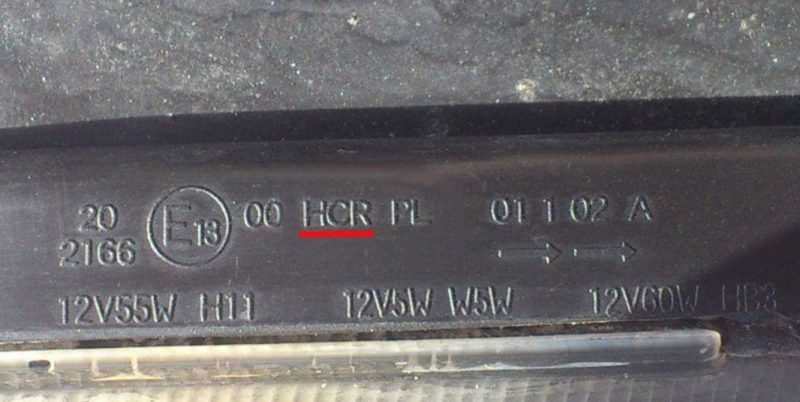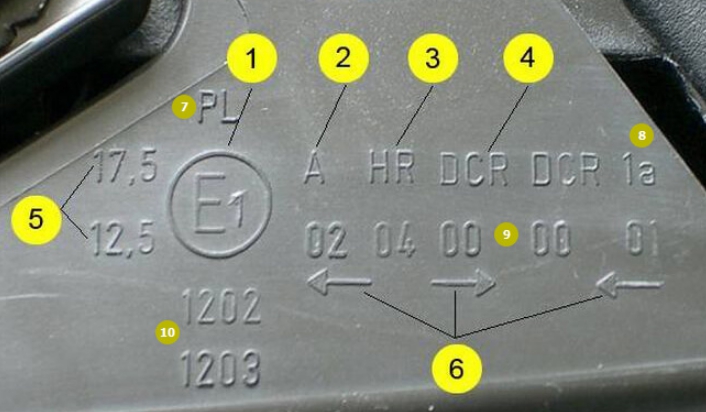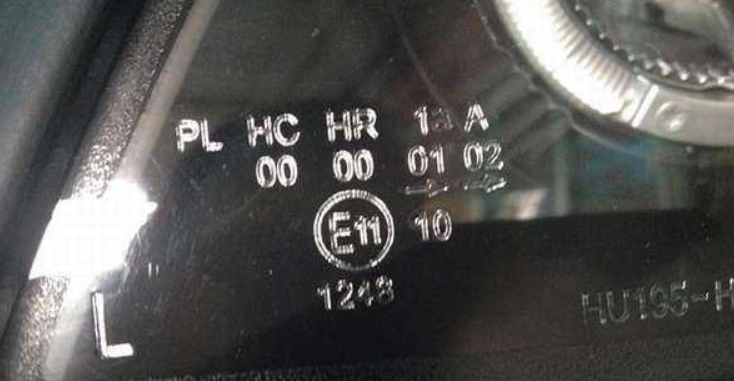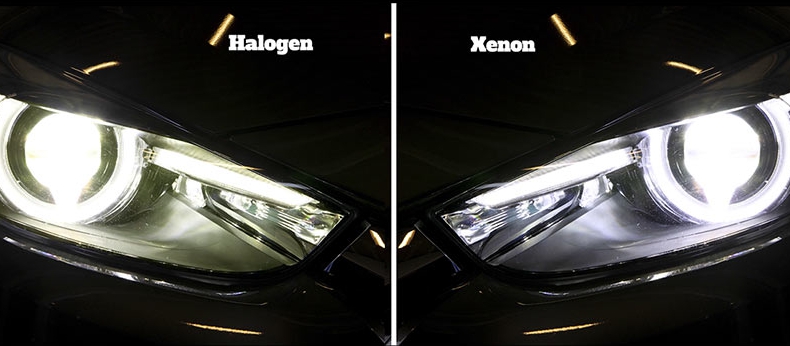Headlights marking and deciphering
Headlight markings are always on the back or side of the body. By studying it you can find out all the necessary information - from the date of manufacture to the type of lamps installed. There is also information about the state that issued the license for the production of headlights, the direction of travel and other characteristics concerning the equipment.
Why headlamp marking is necessary
There are a number of international and domestic standards (e.g. UNECE N99 and GOST R41.99-99), which oblige the producers of lighting equipment for vehicles to mark them to a certain standard. Usually it is a code consisting of Latin letters and numbers, which has the following data:
- The model of the product, its version and modification, if several varieties with certain differences are produced.
- The type of bulbs that can be used in the headlight.
- The main indicators of lighting.
- Category of the product.
- Orientation of luminous flux (usually block headlights are made for right-hand or left-hand traffic and differ in the configuration of the diffuser).
- In which state the certificate was issued.
- Date of manufacture.
By the way! Some brands (Koito, Hella) may indicate additional information.
Usually the data is melted on the body of the headlight. When installed at the factory, a label is also added under the hood, which duplicates the data so as not to remove the headlights when replacing bulbs.

How to decipher the markings correctly
The easiest thing to figure out is the diagram, the layout is always the same. This applies to both main headlights and fog lights, taillights, turn signals and other lighting equipment, if any.
What the Markings Mean
For simplicity and clarity, a diagram showing the location of the different data groups is given first. Below there are explanations to quickly understand and learn all the necessary data about the equipment.

The international approval mark indicated by number "1" tells you in which region the headlights or lights are certified. The most common variants are:
- E - Europe.
- DOT - UNITED STATES.
- SAE - Association of Automotive Engineers.
Next to the letter code is a number that shows the country that issued the certificate. Here are the basic variants:
- FRG.
- France.
- Italy.
- Netherlands.
- Sweden.
- Belgium.
- Hungary.
- Czech Republic.
- Spain
- Yugoslavia (all former countries).
- Britain
- Austria.
- Poland.
- Portugal.
- Russia
These are the main manufacturing countries. Often there is a manufacturer's logo on the case, especially if the brand is well-known. Also, many people mark the country of manufacture for simplicity, so as not to have to deal with codes.
The code under the number 2 indicates the purpose of the headlight. There may be several options:
- A - front parking or side lights.
- L - rear license plate illumination element.
- R - rear lights.
- B - front fog lights.
- F - rear fog lights.
These are the most common variants used in marking.
The number "3" indicates the type of lamp that is installed in the equipment. This aspect is discussed in detail in the next chapter.
The number "4" tells you what kind of lamp to use. Thus, the DCR marking indicates that xenon bulbs can be used for both high beam and low beam.
Under the number "5" on the diagram, the leading main number or VOH, which shows the intensity of the dipped and the driving beam. It's simple - the higher the numbers, the brighter the light the equipment can produce. Such information is applied only to the headlights, which have a dipped and a high beam.
Manufacturers are forbidden to make headlights with MFL above 50 (150,000 candela), and the total must not exceed 75.
The number "6" is usually represented by arrowheads. They tell you which traffic the light source is designed for. If the arrow is to the left - for left-handed, to the right - for right-handed. When there are both arrows, you can use the headlights on roads with different traffic directions, but in this case it is necessary to adjust the equipment to adjust the light output. If there are no markings, it means that the headlight (and this marking is applicable only for headlights) is designed for right-hand traffic, which is more widespread in the world.
If there is a marking on the housing shown in the diagram the number "7", it indicates that the equipment uses polymer diffusers.
The symbol under the number "8" if present, indicates that a reflector was used in the design.
The number "9" is intended for technicians at car repair shops and shows the angles of inclination that should be used as a guide when adjusting the light. They use the data to simplify and speed up the process.

The number "10" informs about the standards to which a particular product conforms. These can be international standards, as well as their own or regional variants. The second line usually reflects the homologation number (improvements to improve performance).
Video: Where to look for a headlight number.
Varieties depending on the type of bulbs
When deciphering the designations, the focus is usually on the type of bulbs used and their features. Currently, there are three varieties that are installed on cars.
Halogen
The most common option, which for several decades was the mainstream. Now it is used less, but while cars with halogen light most of all. As for the marking, it is as follows:
- HR - High-beam bulb.
- HCR - A halogen bulb with two filaments which provides driving and dipped beam.
- HC/HR - The unit has two separate modules for high and low beam sources.
By the way! If the HC/HR marking is on a headlight made in Japan, it can be converted to xenon.
Xenon

This option is increasingly used in cars, as it provides a powerful light of high brightness. You can find the following designations on the headlights:
- D2R. Reflector type, works like regular bulbs.
- D2S. Spotlight type, inserted in the lens and give a concentrated beam of light.
- DC. In these variants xenon is put in the dipped beam.
- DCR. A xenon source for the high beam.
- DC/DR .. Two separate xenon modules for low and high beam.
From the video you will learn the principle of operation and the differences between halogen headlights and xenon headlights.
LED
Headlight marking for LED bulbs has its own peculiarities. This variant can be marked with the standard code HCR, which is also used for halogen elements. But the reflector and lens will always be labeled LED to make it clear that the elements are designed for an LED light source.
If the equipment is designed for diodes, you can not put other light sources in itAs they heat up much more and will damage the reflector or lens.
To understand the marking of headlights is easy, it is always made to a certain standard. This will help you quickly determine what bulbs the equipment is designed for and whether the light source is suitable for right-hand traffic.